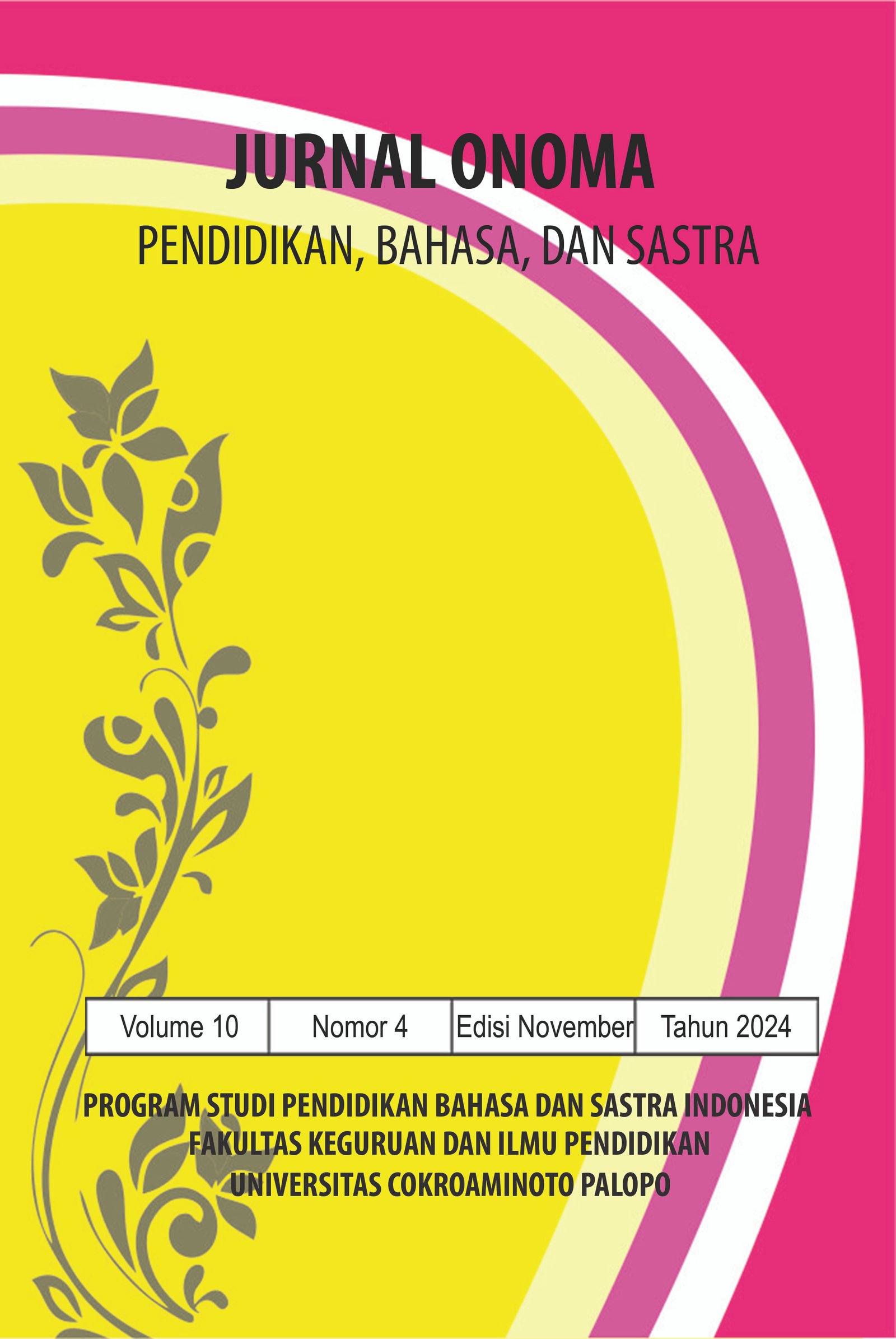Unveiling Lintang's Resilience and Grit: An Appraisal Analysis of 'Tenacity', 'Capacity', and 'Normality' in Laskar Pelangi
https://doi.org/10.30605/onoma.v10i4.4168
Keywords:
Appraisal Study, Judgment Aspect: Social Esteem; Character ofAbstract
This study aims to analyze how language is used to portray Lintang as a resilient and gritty character in the novel Laskar Pelangi, through the theoretical framework of Systemic Functional Linguistics (SFL) and drawing on Martin and White’s (2005) Appraisal theory. The specific objective of this research is to explore how linguistic choices in the novel construct the character of Lintang in terms of his resilience and grit, focusing on the aspects of judgment, particularly tenacity, capacity, and normality. The method used in this study involves a qualitative analysis of textual evidence from the novel. Linguistic elements related to judgment are identified, categorized, and analyzed based on their contribution to portraying Lintang’s resilience and grit. The findings of this study reveal that Lintang's character is constructed through a combination of linguistic elements that emphasize his extraordinary tenacity, strong capacity, and relatable normality. Despite being frequently underestimated due to his simple physical appearance, these linguistic choices underscore his resilience and grit. Lintang’s ability to overcome societal prejudices and physical limitations highlights the message that true success comes from inner strength and persistence. By illustrating Lintang's journey, Hirata effectively conveys that physical appearance does not define one's potential for greatness. This research contributes to the understanding of how literary characters can inspire resilience and grit in readers, providing valuable insights into storytelling methods that emphasize character development through language.
Downloads
References
Bowen, G.A. (2009), "Document Analysis as a Qualitative Research Method", Qualitative Research Journal, Vol. 9 No. 2, pp. 27-40. https://doi.org/10.3316/QRJ0902027 DOI: https://doi.org/10.3316/QRJ0902027
Duckworth, A. L., Peterson, C., Matthews, M. D., & Kelly, D. R. (2007). Grit: Perseverance and Passion for Long-Term Goals. Journal of Personality and Social Psychology, 92(6), 1087-1101. DOI: https://doi.org/10.1037/0022-3514.92.6.1087
Hirata, A. (2005). Laskar Pelangi. Bentang Pustaka.
Khrisna, D. A. N., Nababan, M. R., Djatmika, & Santosa, R. (2017). Analisis Penokohan Santiago dalam Novel The Old Man and The Sea dengan Pendekatan Apraisal. Universitas Sebelas Maret.
Krippendorff, K. (2004). Content Analysis: An Introduction to Its Methodology. Sage Publications.
Martin, J. R., & White, P. R. R. (2005). The Language of Evaluation: Appraisal in English. Palgrave Macmillan.
Masten, A. S. (2001). Ordinary magic: Resilience processes in development. American Psychologist, 56(3), 227-238. DOI: https://doi.org/10.1037//0003-066X.56.3.227
SOLO, R., & TORAJA, M. T. (2023). Universitas Cokroaminoto Palopo, suparman@ uncp. ac. id. Jurnal Penelitian Pendidikan, 8(1).
Miles, M. B., & Huberman, A. M. (1994). Qualitative Data Analysis: An Expanded Sourcebook. Sage Publications.
Sari, S., Mahmudah, M., & Faisal, F. (year). Sikap Tokoh dalam Novel Angin Bersyair Karya Andrei Aksana: Kajian Apraisal J.R. Martin & Rose. Metalingua, 9(1). https://doi.org/10.21107/metalingua.v9i1.23396. DOI: https://doi.org/10.21107/metalingua.v9i1.23396
Seligman, M. E. P. (2002). Authentic Happiness: Using the New Positive Psychology to Realize Your Potential for Lasting Fulfillment. Free Press.
Sodiq, J., Sophia, T. C., & Hidayat, N. (2022). Appraisal analysis of characterization of the main character in Pramoedya Ananta Toer's novel in Indonesian and English translation of This Earth of Mankind. ETERNAL (English Teaching Journal). https://doi.org/10.26877/eternal.v13i1.11199 DOI: https://doi.org/10.26877/eternal.v13i1.11199
Sugiyono. (2015). Metode Penelitian Pendidikan (Pendekatan Kuantitatif, Kualitatif dan R&D). Alfabeta.
Sutopo, H. B. (2002). Metodologi Penelitian Kualitatif: Dasar Teori dan Terapannya dalam Penelitian. UNS Press.
Yin, R. K. (2002). Case Study Research: Design and Methods (3rd ed.). Sage Publications
Downloads
Published
How to Cite
License
In submitting the manuscript to the journal, the authors certify that:
- They are authorized by their co-authors to enter into these arrangements.
- The work described has not been formally published before, except in the form of an abstract or as part of a published lecture, review, thesis, or overlay journal.
- That it is not under consideration for publication elsewhere,
- That its publication has been approved by all the author(s) and by the responsible authorities – tacitly or explicitly – of the institutes where the work has been carried out.
- They secure the right to reproduce any material that has already been published or copyrighted elsewhere.
- They agree to the following license and copyright agreement.
License and Copyright Agreement
Authors who publish with Onoma Journal: Education, Languages??, and Literature agree to the following terms:
- Authors retain copyright and grant the journal right of first publication with the work simultaneously licensed under Creative Commons Attribution License (CC BY 4.0) that allows others to share the work with an acknowledgment of the work's authorship and initial publication in this journal.
- Authors are able to enter into separate, additional contractual arrangements for the non-exclusive distribution of the journal's published version of the work (e.g., post it to an institutional repository or publish it in a book), with an acknowledgment of its initial publication in this journal.
- Authors are permitted and encouraged to post their work online (e.g., in institutional repositories or on their website) prior to and during the submission process, as it can lead to productive exchanges, as well as earlier and greater citation of published work.

















